The best time to visit Cambodia is during the dry season from November to April, when you’ll enjoy temperatures between 77-95°F and minimal rainfall. This peak season offers ideal conditions for exploring temples like Angkor Wat, though you’ll encounter more tourists and higher prices. If you’re looking to save money and don’t mind brief afternoon showers, the monsoon season (May-October) rewards with lush landscapes, dramatic skies, and far fewer crowds. There’s much more to ponder when timing your Cambodian adventure.
Key Takeaways
- Peak tourist season runs from November to April, offering dry weather and comfortable temperatures between 77-95°F (25-35°C).
- December and January provide ideal conditions with minimal rainfall, lower humidity, and pleasant temperatures for temple exploration.
- May to October brings monsoon rains, fewer tourists, and discounted accommodations up to 50% off peak season rates.
- Photography enthusiasts should consider visiting during monsoon season for dramatic skies, lush landscapes, and stunning temple reflections.
- Coastal areas maintain moderate temperatures year-round, while inland regions experience more extreme conditions during both wet and dry seasons.
Weather Patterns & Seasonal Overview
Cambodia’s climate follows two distinct monsoon seasons that shape the entire country’s weather patterns throughout the year. The southwest monsoon dominates from May to October, delivering 75% of the annual rainfall, while the northeast monsoon brings drier conditions from November through March. You’ll experience year-round temperatures between 22-34°C (72-93°F), with April and May being the hottest months.
The wet season transforms Cambodia’s landscape, with daily afternoon thunderstorms and humidity levels reaching 80%. During this time, the iconic Tonle Sap Lake expands dramatically from 2m to 14m in depth. The monsoon rains help sustain broad-leaved evergreen forests in the northern mountainous regions. However, climate change is increasingly affecting these patterns, leading to agricultural disruptions and ecological threats. You’ll find rising temperatures and more extreme weather events, with wet seasons becoming more intense and dry seasons growing longer. This shifting climate is particularly impacting rice production cycles and traditional fishing patterns in the Tonle Sap region.
Peak Season Travel Guide (November-April)
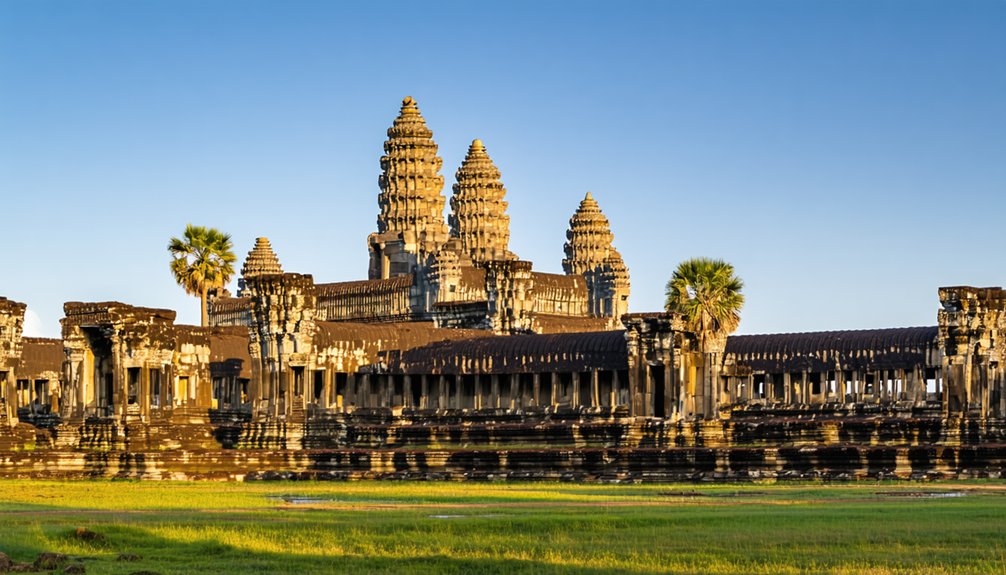
While November marks the start of Cambodia’s coveted peak season, you’ll find the most favorable travel conditions extending through April, with pristine weather and major cultural events drawing visitors worldwide. You’ll experience temperatures ranging from a comfortable 77°F to 95°F, with coastal areas staying particularly mild. During January, visitors can enjoy exploring attractions with reduced humidity levels, making temple visits more comfortable.
Be prepared for increased traffic patterns around major attractions, especially at Angkor Wat, where daily visitors can exceed 10,000 during December and January. Accommodation availability becomes scarce, with rates jumping 30-50% higher than usual. You’ll want to book 3-6 months ahead, particularly for December travels and luxury stays.
To maximize your experience, plan temple visits during early morning hours (5-10AM) to beat both crowds and heat. Consider exploring the Cardamom Mountains between December and February, when trail conditions are ideal and you’ll find relief from the tourist-heavy circuits.
Monsoon Season Discoveries (May-October)
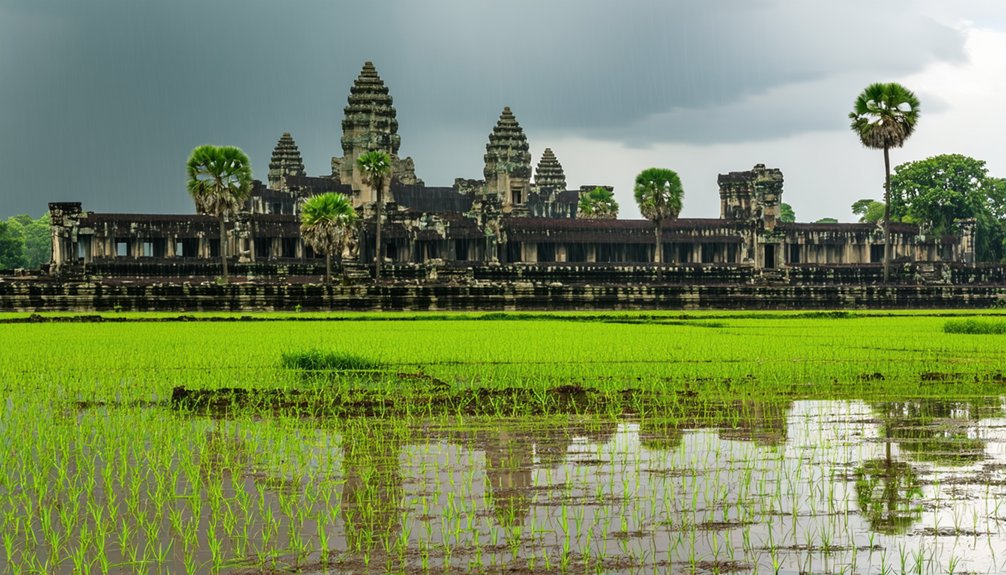
You’ll discover a different side of Cambodia during the monsoon season, when lush landscapes and filled temple moats create stunning photo opportunities with up to 70% fewer tourists at major sites like Angkor Wat. Your travel budget stretches further with hotel rates dropping 30-50%, while the dramatic skies and verdant rice paddies transform the countryside into a photographer’s paradise. The reduced crowds allow for more intimate cultural experiences, especially around the expanded Tonle Sap Lake where local life adapts to the rising waters. Though some sites may be inaccessible due to heavy rain and floods, the unique atmosphere during this season offers a more authentic glimpse of Cambodian life.
Lush Landscapes and Photography
Although monsoon season brings frequent rainfall to Cambodia, this natural phenomenon transforms the country into a photographer’s paradise from May through October. You’ll witness lush greenery blanketing 95% of rural landscapes while vibrant foliage creates stunning natural backdrops throughout the region. Professional photographers navigate these conditions with 250cc dirt bikes to access remote shooting locations.
| Photographic Element | Morning | Evening |
|---|---|---|
| Temple Reflections | Mirror-like pools at Angkor | Dramatic storm clouds |
| Natural Light | Filtered sunlight through mist | Lightning photography |
| Wildlife Activity | Dolphin sightings | Forest life awakening |
The reduced tourist crowds mean you’ll have prime shooting locations to yourself. Capture Taxithelium moss creating living textures on ancient stones, or frame the perfect shot of temple spires reflected in rain-filled pools. For the best results, set your camera to ISO 1600+ during dusk thunderstorms, when nature puts on its most spectacular show.
Budget-Friendly Travel Benefits
Savvy travelers can access substantial savings by visiting Cambodia during the monsoon season from May through October. You’ll find value-driven tourism options across all aspects of travel, with accommodations offering 30-50% discounts and luxury resorts reducing rates by up to 40%. Transportation costs plummet too, with domestic flights, tuk-tuks, and car rentals available at markedly lower prices.
Take advantage of seasonal event discounts during cultural celebrations like Pchum Ben, where you can bundle activities at reduced rates. From discounted Angkor Wat passes to half-price happy hours and “buy one, get one free” restaurant deals, your money stretches considerably further. Even premium experiences become more accessible, with guided temple tours, cooking classes, and river cruises offering considerable monsoon season reductions. With fewer tourists in May, you’ll have more flexibility in booking and greater negotiating power for tours and activities.
Authentic Cultural Immersion
The monsoon season transforms Cambodia into a cultural treasure trove, offering visitors unparalleled opportunities to experience authentic Khmer traditions. You’ll discover rural immersion experiences through participating in rice planting ceremonies, exploring floating villages on Tonle Sap Lake, and witnessing traditional fishing methods passed down through generations.
Community based tourism opportunities abound during this time, from joining Buddhist Lent ceremonies at local pagodas to engaging with silk weavers in Koh Dach. You can taste seasonal delicacies like Samlor Korkor and fresh fish curry while watching traditional Khmer music performances. The reduced tourist crowds mean you’ll have intimate access to cultural festivals like Pchum Ben, where you can observe ancestor veneration rituals and connect with local communities in a more meaningful way. With the Queen Mother’s Birthday on June 18, visitors can witness grand parades and ceremonies at the Royal Palace in Phnom Penh.
Temple Exploration & Photography Tips
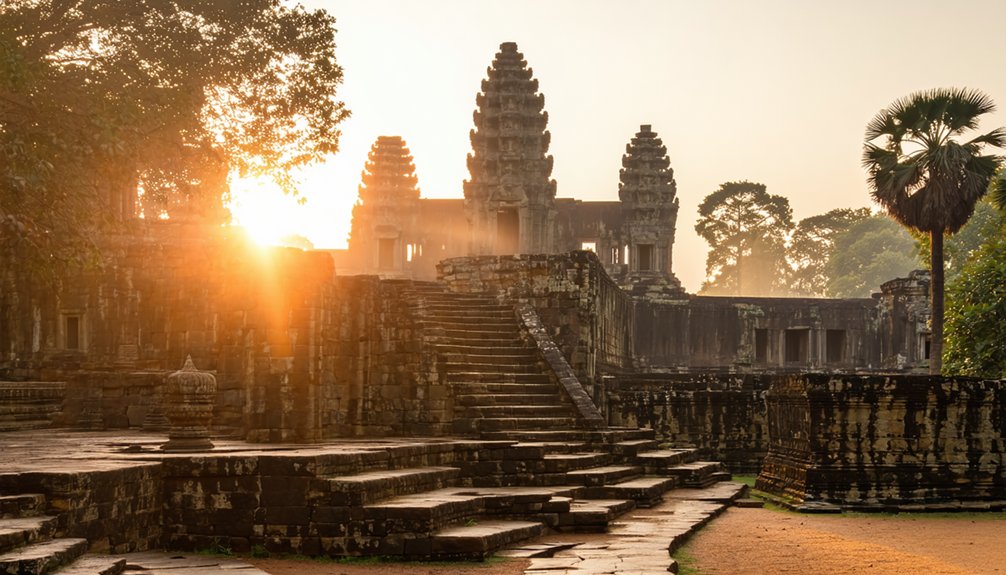
Capturing Cambodia’s ancient temples requires careful timing and technical know-how to achieve stunning results. For the best sunrise photography opportunities, position yourself at Angkor Wat’s reflecting pools before dawn, when you’ll catch dramatic silhouettes against the warming sky. During monsoon season, you’ll find moats filled with water, creating perfect mirror images of the temples, while shoulder seasons offer fewer crowds and mystical lighting conditions. November through March tends to bring higher crowd levels at temple sites, making photography more challenging.
To maximize your temple photography experience:
- Pack essential gear including a sturdy tripod, wide-angle lens (16-35mm), and polarizing filter for managing reflections
- Visit popular temples during off-peak hours – early morning or late afternoon – when tourist numbers thin
- Adjust your shooting technique based on conditions: use split ND filters during harsh midday light, and embrace overcast skies for even illumination of intricate stone carvings
Remember to dress respectfully and maintain cultural sensitivity while photographing active religious sites.
Regional Climate Variations Across Cambodia
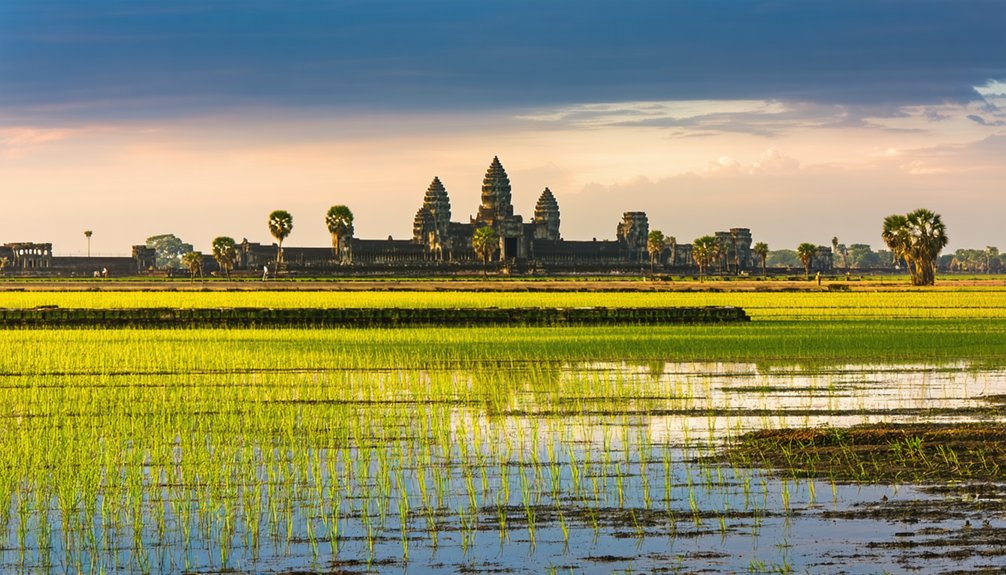
When planning your Cambodian adventure, you’ll notice stark climate differences between coastal areas, which maintain steady temperatures of 24-32°C with high humidity, and the inland regions that experience more dramatic seasonal shifts. The northern provinces face the most significant temperature increases (+0.29°C/decade) and are projected to see an 8% decrease in annual rainfall by midcentury, while the Eastern Highlands offer cooler temperatures ranging from 20-30°C year-round. You’ll find the Tonle Sap basin‘s unique seasonal patterns particularly dramatic, as the lake’s depth swells to 14 meters during monsoon floods, creating a completely different landscape from the dry season. The Gulf of Thailand borders the southwest coast, influencing the climate patterns of the coastal regions.
Coastal Vs Inland Weather
Understanding Cambodia’s diverse weather patterns can help you plan the perfect trip, as coastal and inland regions experience markedly different climates throughout the year. While coastal areas enjoy moderate temperatures year-round thanks to sea breezes, inland regions face greater weather variability concerns that affect rice cultivation patterns and travel conditions. Visitors planning trips to Phnom Penh should note that the capital sees around 2,500 hours of sunshine annually.
Key differences between coastal and inland weather:
- Coastal zones receive double the rainfall (4,000mm vs 1,800mm inland) with peak precipitation in July-August
- Inland areas experience more extreme temperatures, reaching 40°C in March-April, while coastal regions stay around 32°C
- The dry season hits inland regions harder, with less than 20mm monthly rainfall from December to February, making it ideal for temple exploration
Northern Highland Climate Patterns
While coastal and inland regions showcase distinct weather patterns, Cambodia’s northern highlands present their own unique climate story. You’ll find noticeably cooler temperatures here, with elevations reaching 1,800 meters in the Cardamom Mountains. Daytime temperatures typically range from 21-29°C, offering a rejuvenating escape from the lowland heat.
These highlands receive substantial rainfall, averaging 2,000-4,000mm annually, which sustains dense evergreen forests and provides essential habitats for endangered species protection. For the best highland experience, visit during December and January when clear skies and mild temperatures create ideal conditions for sustainable tourism practices like trekking. The northeast monsoon influence helps maintain these cooler temperatures throughout the winter months. Be prepared for afternoon thunderstorms during the wet season (May-October) and occasional morning fog in the valleys during early dry season.
Tonle Sap Seasonal Changes
The remarkable Tonle Sap Lake stands as Cambodia’s beating heart, where seasonal monsoons orchestrate one of Earth’s most dramatic natural transformations. You’ll witness the lake’s extraordinary flood pulse cycles as it expands up to seven times its dry-season size between June and October, with depths increasing from 1-3 meters to an impressive 9-14 meters.
The dry northeast monsoon brings minimal rainfall from November through April, significantly impacting water levels.
During your visit, you’ll notice three distinct phases:
- Northwest flow (June-October): Lake expands dramatically, fertilizing over 750,000 hectares of farmland
- Peak expansion (September-October): Perfect time to explore floating villages
- Southeast drainage (November-May): Waters recede into the Mekong Delta, revealing vast fishing grounds
These lake depth variations directly influence local fishing communities and create unique opportunities for cultural immersion, especially during the spectacular September-October peak.
Cultural Festivals & Event Calendar
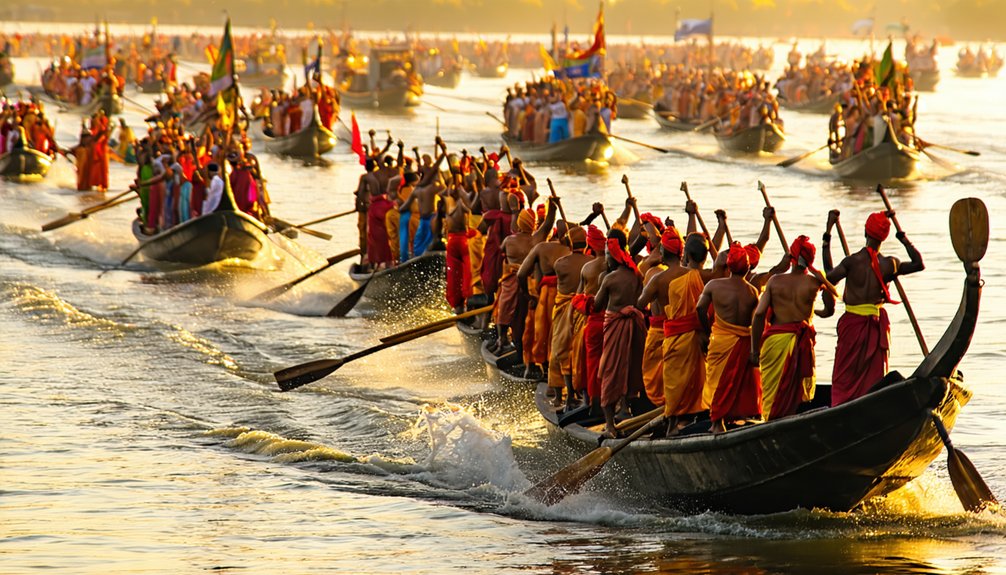
Throughout Cambodia’s vibrant calendar year, you’ll discover a rich tapestry of cultural festivals that blend Buddhist traditions, agricultural celebrations, and historical commemorations. Major events like Khmer New Year in April and Pchum Ben in September offer immersive experiences in traditional rites and religious pilgrimages, while the spectacular Water Festival in November transforms Phnom Penh’s riverfront with boat races and illuminated floats. Buddhist devotees gather at temples to present flowers and lotus buds as sacred offerings.
You won’t want to miss the Royal Ploughing Ceremony in May, where ancient customs meet modern celebrations as royal oxen predict the year’s harvest. For contemporary culture, catch the Angkor Photo Festival or the innovative Giant Puppet Parade in Siem Reap. The festival calendar aligns perfectly with Cambodia’s seasons – the dry season (November-March) hosts the most vibrant celebrations, while the rainy season brings unique atmospheric charm to events like Pchum Ben, when locals honor their ancestors through temple offerings.
Budget Planning & Seasonal Pricing
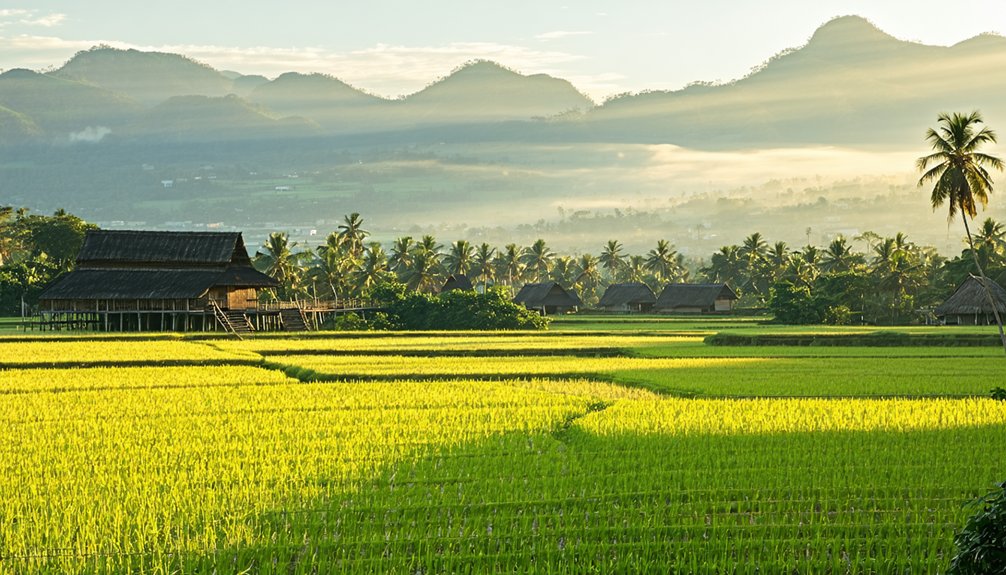
You’ll find significant price variations between Cambodia’s peak season (December-April) and off-season (May-October), with high-season rates climbing up to 30% above normal for accommodations and activities. Your travel budget will stretch considerably further during the off-season months, when hotels offer discounts up to 50% and tourist attractions reduce their prices by 20-40%. Booking through online platforms can save you an additional 10-20% on accommodations year-round, making budget planning more manageable regardless of when you visit. November visitors can enjoy low season rates while still experiencing comfortable weather conditions.
Peak Vs Off-Season Rates
Price-conscious travelers will find substantial savings by timing their Cambodian adventure strategically. During off-season months (May-September), you’ll discover seasonal discounts of up to 41% on accommodations and tours compared to peak rates, while accommodation price trends show dramatic spikes from November through February. With 34.7% of visitors arriving by air, international flight availability and pricing significantly impact travel budgets.
- Flight costs fluctuate drastically, with peak season fares from Europe and USA jumping 40-60%, while off-season flights from Asian hubs like Bangkok drop to appealing $80-120 ranges
- Temple passes and guided tours offer considerable savings, with Angkor Wat daily passes costing $20-25 in off-season versus $37 during peak months
- Local transport and activities follow similar patterns, with tuk-tuk fares, motorbike rentals, and adventure activities costing 20-40% less during low season
Accommodation Cost Fluctuations
While planning your Cambodian getaway, understanding accommodation costs can make or break your budget. You’ll find significant price variations between high season (November-April) when rates surge by 20%, and low season (May-October) offering 10-30% discounts, especially in coastal areas. Couchsurfing and housesitting can provide completely free accommodation for the adventurous traveler.
Regional pricing differs dramatically across the country. While Phnom Penh commands $350-2,000 monthly for apartments, you’ll find bargains in Battambang at $80-450. For budget travelers, hostels provide dorm beds from $4-25 nightly, while private rooms range from $8-50. Consider discounted long stay options, particularly during off-peak months, when luxury hotels in Siem Reap drop to $50-80 per night. Rural guesthouses offer the best value at $6-12 nightly, though you might sacrifice amenities like Wi-Fi or air conditioning.
Essential Packing Tips by Season

Packing strategically for Cambodia’s distinct seasons can make or break your travel experience. Your packing considerations should align with both weather patterns and cultural requirements, particularly when visiting temples. During the dry season (November-February), seasonal layering becomes essential as temperatures fluctuate between warm days and cool evenings. Temperatures typically stay around 30 degrees Celsius during the cooler months of the dry season.
Smart packing for Cambodia means adapting to seasonal changes while respecting cultural norms, especially at sacred sites.
For ideal comfort and cultural respect across all seasons, remember these key items:
- Temple-ready attire: Pack loose linen pants and shoulder-covering tops for sacred sites
- Weather protection: Bring season-specific gear (lightweight layers for dry season, quick-dry clothing and rain gear for wet season)
- Health essentials: Carry a medical kit, water purification tools, and sun protection
The rainy season (May-October) demands waterproof gear and mosquito defenses, while the hot dry months (March-April) require moisture-wicking fabrics and cooling accessories. Don’t forget temple-specific items like slip-on shoes and modest clothing regardless of when you visit.
Multi-Destination Travel Planning

Savvy travelers exploring Southeast Asia often combine their Cambodia visit with neighboring countries to maximize their journey. You’ll find the dry season (November-April) offers the most flexibility for multi-country exploration, particularly when syncing with Vietnam’s southern regions. Both Vietnam and Cambodia offer excellent opportunities for independent budget travel.
Consider open-jaw flights to eliminate backtracking – fly into Hanoi and out of Phnom Penh, for instance. For Vietnam connections, river cruises from Chau Doc to Phnom Penh provide a scenic alternative to bus travel. If you’re heading to Thailand, explore overland routes between Siem Reap and Thailand via Battambang, which serves as an excellent stopover point.
Avoid planning multi-country trips during August-September when monsoons can disrupt travel, especially in northern Laos. For budget-conscious travelers, cross-border buses offer significant savings compared to flights, though they’ll take longer. Remember to factor in festival dates, as events like Khmer New Year can impact transportation availability and accommodation prices across the region.
Best Activities Month by Month
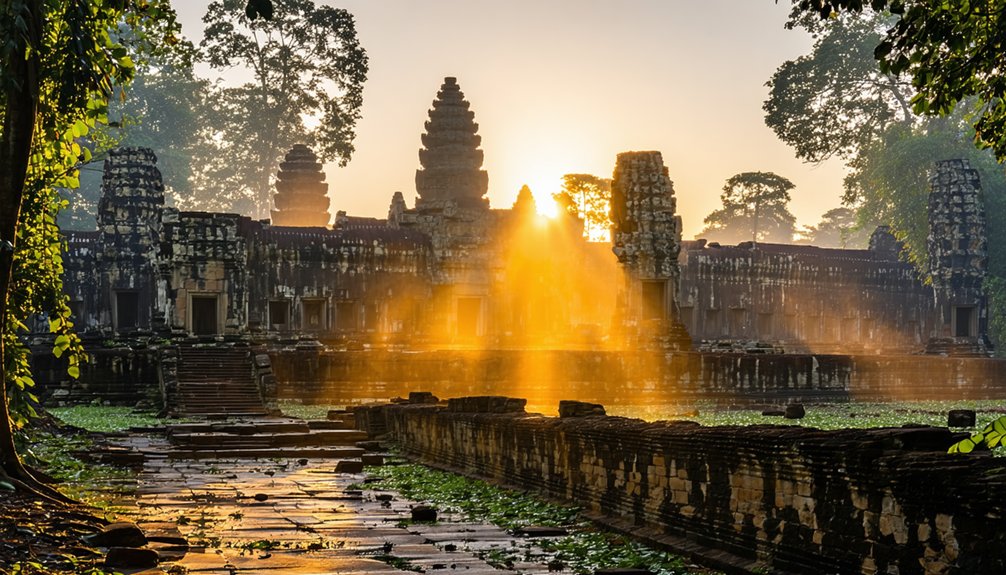
Cambodia’s calendar offers distinct opportunities throughout the year, and knowing what’s best each month can help you plan an unforgettable experience. The cooler months from November through February present the ideal window for temple exploration, making it perfect for daytrip experiences to the iconic Angkor complex. One of the most exciting times to visit is during the traditional Khmer festivals which showcase the country’s vibrant cultural heritage.
During this optimal season, you’ll find these key advantages:
- Temperatures are more moderate, allowing for longer outdoor adventures
- Lower humidity creates perfect settings for weekend getaways to remote temples
- Clear skies provide excellent photography opportunities at ancient sites
While temples are accessible year-round, timing your visit during these peak months guarantees you’ll explore in comfort. You can spend full days wandering through ancient corridors without the intense heat that characterizes other seasons. This period also aligns well with regional travel, making it easier to combine your Cambodia adventure with visits to neighboring countries.





